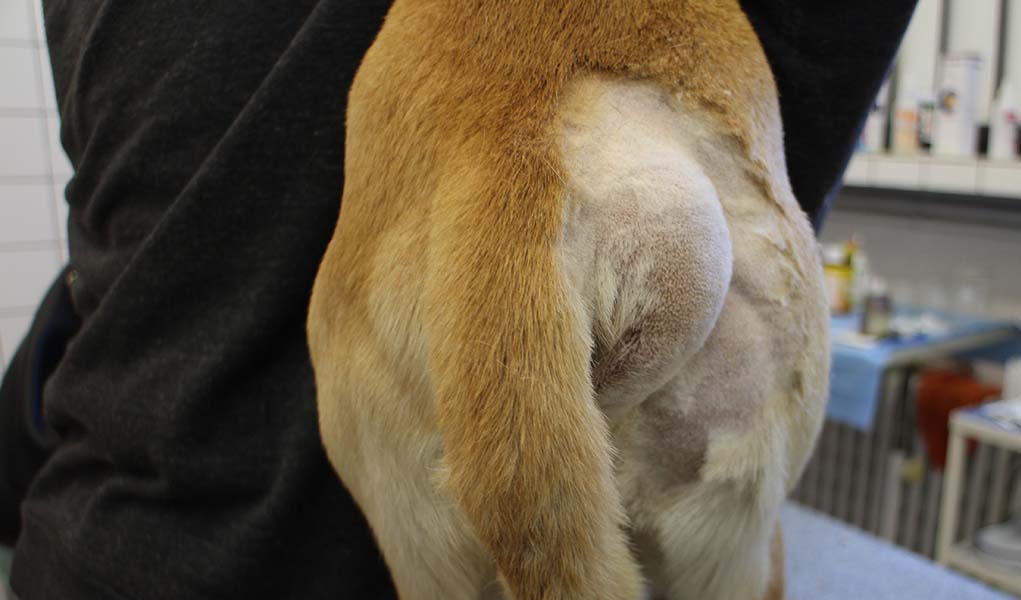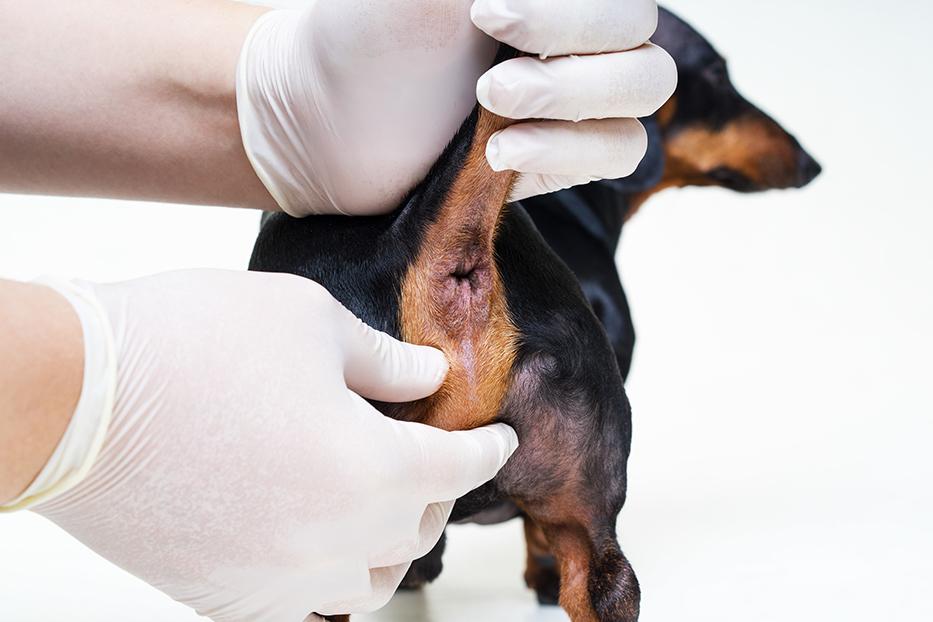Anal glands dog
The dog's anal glands are an unappetizing subject, but it is necessary to look into them in order to be able to take care of your pet's health in all circumstances.
Indeed, like all other parts of the dog's body, they are subject to various ailments, serious or benign, that should not be ignored. In today's article, I'd like to tell you a little more about the dog's anal glands and the disorders associated with them.
What are the dog's anal glands?
The dog's anal glands, whose real medical name is anal sacs, are two cavities located on each side of the anus. They contain an odorous liquid - the scent of which is reminiscent of rotting fish - that serves as a unique olfactory signature for each dog.
The dog's anal glands empty themselves when he relieves himself, spreading their contents, partly composed of pheromones, on the animal's excrement so that his fellow dogs can know that he has passed through. This is how our four-legged friends mark their territory, an ability that is somewhat meaningless in the age of domestication, but which is very important in nature.
The secretions produced by the anal glands are thick and sticky, and can range in color from whitish yellow to red, beige, brown, gray or orange. The exact composition of this substance is unique to each dog, and even varies from day to day, for example, depending on the bitch's hormonal cycles.
This is not surprising, since the liquid in the anal glands is used to send a message and can therefore change depending on the animal's mood. Finally, it is important to know that the dog's anal glands naturally contain bacteria, and their presence in this unusual place is completely normal and does not indicate any disease.
The fluid in the dog's anal sacs is often passively excreted when the dog defecates, but it can also be actively expelled, for example in a panic, sometimes spurting out more than a meter away from the dog.

Role of the anal glands in the dog
As mentioned above, a dog's anal glands are used to secrete a fluid that allows him to communicate with his peers. And, believe it or not, the sticky substance that comes out of these misplaced sacs is particularly talkative. It allows the dog to identify itself, including its age and sex, to ward off rivals and attract a potential mate.
The pheromones secreted by the anal glands also allow the dog to announce its status, and to shout from the rooftops - or rather from the sidewalks - that it is the leader. In the same vein, the liquid contained in the anal sacs of a dog allows him to signal that he belongs to a pack. Finally, the fluid in a dog's anal glands allows it to emit alarm signals, leaving a mark that signals danger or threat.
All of these elements make it clear why it is important to keep the dog's anal glands healthy. Since they are fully involved in communication between different individuals, they play a major role in the animal's social behavior and, ultimately, its well-being.
It happens, for example, that dogs with infected anal sacs are not recognized by their peers, and that their posterior problems cause trouble in a pack, even though the poor animal had no intention of offending his fellow dogs, and even less his hierarchy...
The main diseases of the dog's anal glands
Impaction and inflammation of the anal glands in dogs
Sometimes, more frequently than one would like, a dog's anal glands become blocked, a phenomenon known as impaction. The blocked glands can no longer expel the secretions they produce and become swollen and painful. When impaction lasts too long, it often becomes inflamed.
There are many causes of anal impaction: diarrhea, change in diet, hypersecretion, intestinal worms... Note that small breeds are more prone to anal impaction, but unfortunately no dog is spared. If you're not afraid of doing something unglamorous, you can often relieve your dog yourself by rolling up your sleeves and holding your breath.
All you have to do is feel around your dog's anus until you can feel his anal glands, two balls that are located precisely 4 and 8 o'clock from the animal's orifice. Note that it is quite possible that only one gland is inflamed. Then gently squeeze these balls to get all the fluid out of them. If your pet is in too much pain to let it go, you should see a veterinarian. The problem may be more serious than just inflammation from overflowing anal sacs.
Abscess and infection of the anal glands in dogs
Infection of the dog's anal glands usually occurs as a result of impaction, when the glands have not been emptied in time and bacteria have taken advantage of the opportunity to grow in their stagnant secretions. If the infection of the anal glands is not treated, an abscess can form, which can lead to a chain of complications, including rupture of the anal sac and infection of the surrounding tissue.
The dog, overwhelmed by the pain, walks with difficulty, does not sit up, licks itself constantly, avoids defecating and generally shows obvious signs of distress. This type of disorder is particularly painful and is treated under anesthesia. The anal glands are emptied and the dog is treated with antibiotics.
Sometimes anal gland infections recur, in which case it may be necessary to surgically remove the sensitive sac(s) to avoid repeated abrasive care that will ultimately do more harm than good to the animal. Moreover, repeated infections are indeed conducive to the establishment of an inflammatory environment that can promote the occurrence of cancers.
Anal gland tumors in dogs
Unfortunately, tumors do not spare any organ in dogs, and the anal glands are no exception. A tumor is a mass that can sometimes be seen or felt in the anal gland, and which can cause impaction and, consequently, inflammation.
The most common tumors found in the dog's anal glands are adecarcinomas, which are malignant masses that can lead to cancer. Squamous cell carcinomas and melanomas of the anal glands, another type of malignant tumor, can also be found, but are less frequent.
Usually, a tumor is asymptomatic, and its presence can only be detected by observing a mass next to the dog's anus. However, some dogs may scratch, lick, have difficulty defecating, and the tumor may eventually bleed or ulcerate.
The prognosis of a dog with an anal gland tumor depends on how early it is diagnosed: the earlier the stage of the disease, the better the dog's chances. The preferred treatment is usually surgical removal, when possible. Adjuvant treatments (chemotherapy and/or radiotherapy) can be implemented, although this type of protocol is rarely prescribed in dogs because of the constraints it implies for the owner.

FAQ
What are the dog's anal glands?
The dog's anal glands are small sacs located on either side of the anus, which contain a very fragrant liquid that allows the dog to mark its territory.
How to treat inflamed anal glands in dogs?
An impaction or inflammation of the dog's anal glands occurs when they are blocked and can no longer evacuate the liquid they contain. It is important to empty them to avoid complications: the owner can do it himself if the dog is not in too much pain by gently squeezing them between his thumb and index finger. If the dog suffers too much or the inflammation persists after the first attempt by the owner, the dog should be taken to a veterinarian.
What are the common diseases of the dog's anal glands?
The most common disease of the dog's anal glands is impaction or inflammation, in which the glands become blocked, swollen and painful. Inflammation of the anal glands can be complicated by infection or abscess. Tumors can also colonize the dog's anal glands: in most cases, they are unfortunately malignant.
Why does my dog have swollen anal glands?
A dog with swollen anal glands probably has an impaction or inflammation of the glands. If the animal does not seem to be in too much pain, you can try to gently squeeze the glands to empty them. If you are unable to empty your dog's anal glands, or if the swelling persists, prompt veterinary attention is necessary.
The dog's anal glands can be subject to various pathologies, benign or severe, often requiring a veterinary consultation. As such, it is advisable to monitor them like any other part of your four-legged friend's body, even if they are not very well placed...
A constant bad odor from your dog's hindquarters or mouth, excessive licking, signs of discomfort or pain when defecating, are all symptoms that may indicate a problem with your dog's anal sacs.

